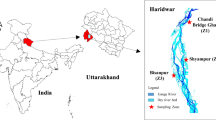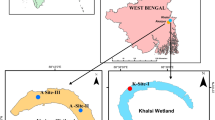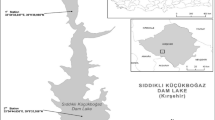Abstract
Most of the ecological studies on mine water have been done in riverine systems, although mine-fed waterways have also been thoroughly studied. Because lakes are thought to recuperate from degradation more slowly than riverine systems, the effects of mine water on lakes are also noteworthy. In India, coal mining first began in the Raniganj coalfield (RCF). There are multiple coal mine-generated pit lakes in the RCF, West Bengal, India; however, there is a fractured and inadequate knowledge of their biological state. Washing, cleaning, and farming are all done with pit lake water. Given their core food web location, zooplankton is a good bioindicator and can be used to access the ecological health of water bodies. The spatio-temporal variation and diversity of major zooplankton groups were studied in five selected pit lakes. Zooplankton, aquatic macrophytes, sediment samples and water samples were collected during three hydrological seasons (viz., pre-monsoon, monsoon and post-monsoon). A total of 180 samples were collected (36 from each site, constituting six samples in different locations per site per season) between January 2018 and December 2019 in each pit lake. The spatio-temporal variation of the zooplankton community was found in the studied pit lakes. A total of 25 Rotifera, 7 Copepoda and 9 Cladocera were identified. Copepoda dominated the zooplankton communities in most of the studied pit lakes. Rotifera was more diverse in the Bonbedi Pit Lake, while Copepoda and Cladocera were dominant in the Dalmia Pit Lake. Canonical correspondence analysis (CAA) assesses the effect of some of the water quality, sediment parameters, and aquatic macrophytes on zooplankton density and diversity. Although pit lakes are ecologically unstable, they share some attributes with natural systems and play important roles. The finding adds to our understanding of zooplankton structure and diversity in pit lakes formed by coal mining. The existence and density of zooplankton were found to be related to the quality of their environment, and the zooplankton community delivers basic information about the ecological status of the pit lake, assisting in the formulation of appropriate planning for improved water quality management and could aid in making decisions about water reclamation strategies and conservation of pit lake ecosystem.




Similar content being viewed by others
References
Ali MM, Mageed AA, Heikal M (2007) Importance of aquatic macrophyte for invertebrate diversity in large subtropical reservoir. Limnologica 37:155–169
APHA (2005) Standard methods for the examination of water and wastewater, 21st edn. APHA, Washington
Armengol X, Miracle MR (2000) Diel vertical movements of zooplankton in Lake La Cruz (Cuenca Spain). J Plankton Res 22(9):1683–1703
Arora J, Mehra NK (2003) Species diversity of planktonic and epiphytic Rotifera in the Backwaters of the Delhi Segment of the Yamuna River, with remarks on new records from India. Zool Stud 42:239–247
Audet CS, MacPhee KW (2013) Colonization of constructed ponds by crustacean zooplankton: local and regional influences. J Limnol 72:43
Barko JW, Gunnison D, Carpenter SR (1991) Sediment interactions with submersed macrophyte growth and community dynamics. Aquat Bot 41(1–3):41–65
Battish SK (1992) Freshwater zooplankton of India. Oxford and IBH Publishing Co., New Delhi, p 232
Beisner BE, Peres-Neto PR, Lindström ES, Barnett A, Longhi ML (2006) The role of environmental and spatial processes in structuring lake communities from bacteria to fish. Ecology 87:2985–2991
Bērzinš B, Pejler B (1987) Rotifera occurrence in relation to pH. Hydrobiologia 147(1):107–116
Blindow IA, Hageby BMA, Wagner AG (2000) How important is the crustacean plankton for the maintenance of water clarity in shallow lakes with abundant submerged vegetation? Freshw Biol 44:185–197
Chapman D (1996) Water quality assessment: a guide to the use of biota, sediments and water in environmental monitoring. University Press, Cambridge
Ciszewski D, Aleksander-Kwaterczak U, Pociecha A, Szarek-Gwiazda E, Waloszek A, Wilk-Woźniak E (2013) Small effects of a large sediment contamination with heavy metals on aquatic organisms in the vicinity of an abandoned lead and zinc mine. Environ Monit Assess 185(12):9825–9842
Die’guez MC, Gilbert JJ (2002) Suppression of the Rotifera Polyarthra remata by omnivorous Copepoda Tropocyclops extensions: predation or competition. J Plankton Res 24(4):359–369
Edmondson WT (1959) Rotifera. In: Edmondson WT (ed) Freshwater biology, 2nd edn. Wiley, New York, pp 420–494
Ejsmont-Karabin J (2013) An analysis based on rotifer indices of the effect of water and sewage management on the water quality in the system of interconnected glacial lakes. Limnol Rev 13:191–195
Gammons CH, Harris LN, Castro JM, Cott PA, Hanna B (2009) Creating lakes from open pit mines: processes and considerations, with emphasis on northern environments. Can Tech Rep Fish Aquat Sci 2826:1–106
Gazonato Neto AJ, da Silva LC, Saggio AA, Rocha O (2014) Zooplankton communities as eutrophication bioindicators in tropical reservoirs. Biota Neotrop 14:1–12
Gianluca AT, Engelen J, Brans KL, Hanashiro FTT, Vanhamel M, van den Berg EM, Souffreau C, De Meester L (2018) Taxonomic, functional and phylogenetic metacommunity ecology of Cladoceran zooplankton along urbanization gradients. Ecography 41:183–194
Giering SLC, Wells SR, Mayers KMJ, Schuster H, Cornwell L, Fileman E, Atkinson A, Cook KB, Preece C, Mayor DJ (2019) Seasonal variation of zooplankton community structure and trophic position in the Celtic Sea: A stable isotope and biovolume spectrum approach. Prog Oceanogr 177:101943
Goździejewska A, Tucholski S (2011) Zooplankton of fish culture ponds periodically fed with treated wastewater. Pol J Environ Stud 20:67–79
Goździejewska A, Glińska-Lewczuk K, Obolewski K, Grzybowski M, Kujawa R, Lew S, Grabowska M (2016) Effects of lateral connectivity on zooplankton community structure in floodplain lakes. Hydrobiologia 774:7–21
Goździejewska AM, Skrzypczak AR, Paturej E, Koszałka J (2018) Zooplankton diversity of drainage system reservoirs at an opencast mine Anna Maria Goździejewska. Knowl Manag Aquat Ecosyst 419:33. https://doi.org/10.1051/kmae/201802
Gray DK, Arnott SE (2011) Does dispersal limitation impact the recovery of zooplankton communities damaged by a regional stressor? Ecol Appl 21:1241–1256
Gupta PK (2004) Methods in environmental analysis: Water, soil and air. Agrobios, Jodhpur (India)
Hammer O, Harper DAT, Ryan PD (2001) PAST: Paleontological statistics software package for education and data analysis. Palaeontol Electron 4(1):1–9
Hayashi M (2004) Temperature-electrical conductivity relation of water for environmental monitoring and geophysical data inversion. Environ Monit Assess 96:119–128
Hussain A, Sulehria A, Ejaz M, Maqbool A (2013) Monthly variations in physicochemical parameters of a flood plain reservoir on River Ravi near Balloki Headworks (Pakistan). Biologia 59:371–377
Inaotombi S, Gupta PK, Mahanta PC (2016) Influence of abiotic factors on the spatio-temporal distribution of rotifers in a subtropical lake of Western Himalaya. Water Air Soil Pollut 227:50
Jack JD, Thorp J (2002) Impacts of fish predation on an Ohio River zooplankton community. J Plankton Res 24(2):119–127
Jackson ML (1973) Soil chemical analysis. Prentice Hall of India Pvt. Ltd., New Delhi, p 498p
Jenkins DG, Buikema AL (1998) Do similar communities develop in similar sites? A test with zooplankton structure and function. Ecol Monogr 68:421–443
Jeppesen E, Jensen JP, Søndergaard M, Lauridsen T (1999) Trophic dynamics in turbid and clear water lakes with special emphasis on the role of zooplankton for water clarity. Hydrobiologia 408(409):217–231
Lapčík V, Lapčíková M (2011) Environmental impact assessment of surface mining. Inz ynieria Mineralna. J Pol Mineral Eng Soc 1/6:1–10
Lauridsen TE, Jeppesen F, Landkildehus SM (2001) Horizontal distribution of Cladocerans in Arctic Greenland—impact of macrophytes and fish. Hydrobiologia 442:107–116
Lipsey LL (1980) Phytoplankton of selected borrow pit ponds in northern Illinois. Ohio J Sci 80:108–113
Maiti SK (2007) Bioreclamation of coalmine overburden dumps—with special emphasis on micronutrients and heavy metals accumulation in tree species. Environ Monit Assess 125:111–122
Manickam NPS, Bhavan PS, Santhanam P, Bhuvaneswari R, Muralisankar T, Srinivasan V, Asaikkutti A, Rajkumar G, Udayasuriyan R, Karthik M (2018) Impact of seasonal changes in zooplankton biodiversity in Ukkadam Lake, Coimbatore, Tamil Nadu, India, and potential future implications of climate change. J Basic Appl Zool 79:15
Margalef DR (1958) Information theory in ecology. General Syst Yearbook 3:36–71
Marques SC, Pardal MA, Pereira MJ, Gonçalves F, Marques JC, Azeiteiro UM (2007) Zooplankton distribution and dynamics in a temperate shallow estuary. Hydrobiologia 587:213–223
Marszelewski W, Dembowska E, Napiórkowski P, Solarczyk A (2017) Understanding abiotic and biotic conditions in post-mining pit lakes for efficient management: a case study (Poland). Mine Water Environ 36:418–428
May L, O’Hare M (2005) Changes in Rotifera species composition and density along a trophic gradient in Loch Lomond, Scotland, UK. Hydrobiologia 546:397–404
McCullough CD, Vandenberg J (2020) Studying mine pit lake systems across multiple scales. Mine Water Environ 39:173–194
McKinstry CAE, Campbell RW (2018) Seasonal variation of zooplankton abundance and community structure in Prince William Sound, Alaska, 2009–2016. Deep Sea Research Part II Top Stud Oceanogr 147:69–78
Mercuri AM, Duggin JA, Grant CD (2005) The use of saline mine water and municipal wastes to establish plantations on rehabilitated open-cut coal mines, Upper Hunter Valley NSW, Australia. For Ecol Manag 204(2–3):195–207
Merrix-Johnes FL, Thackeray SJ, Ormerod SJ (2013) A global analysis of zooplankton in natural and artificial fresh waters. J Limnol 72:140–153
Mimouni E-A, Pinel-Alloul B, Beisner BE, Legendre P (2018) Summer assessment of zooplankton biodiversity and environmental control in urban waterbodies on the Island of Montreal. Ecosphere 9:e02277
Mollema PN, Antonellini M (2016) Water and (bio) chemical cycling in gravel pit lakes: a review and outlook. Earth Sci Rev 159:247–270
Moreira FWA, Leite MGP, Fujaco MAG, Mendonça FPC, Campos LP, Sant’Anna EME (2016) Assessing the impacts of mining activities on zooplankton functional diversity. Acta Limnol Bras 28:107
Naumenko EN (2009) Zooplankton in different types of estuaries (using Curonian and Vistula estuaries as an example). Inland Water Biol 2(1):72–81
Nogueira MG (2001) Zooplankton composition, dominance and abundance as indicators of environmental compartmentalization in Jurumirim Reservoir (Paranapanema River), São Paulo, Brazil. Hydrobiologia 455:1–18
Oh HJ, Jeong HG, Nam GS, Oda Y, Dai W, Lee EW, Chang KH (2017) Comparison of taxon-based and trophi-based response patterns of Rotifera community to water quality: applicability of the Rotifera functional group as an indicator of water quality. Anim Cells Syst 21:133–140
Olsen SR, Cole CV, Watanabe FS, Dean LA (1954) Estimation of available phosphorus in soils by extraction with sodium bicarbonate. United States Department of Agriculture, Washington, p 19 (Circular No. 939)
Overholt EP, Kevin CR, Williamson C, Fischer JM, Cabrol NA (2016) Behavioral responses of freshwater calanoid Copepoda to the presence of ultraviolet radiation: avoidance and attraction. J Plankton Res 38(1):16–26
Pal S, Mukherjee AK, Senapati T, Samanta P, Mondal S, Ghosh AR (2013) Surface water quality assessment of abandoned opencast coal pit-lakes in Raniganj coalfields area, India. Eco Scan 4:175–188
Pandey A, Upadhyay HC (2016) Studies on zooplankton diversity of western Ramganga River in Almora (Uttarakhand) India. Int J Sci Res 5(5):1192–1194
Pielou EC (1966) Species diversity and pattern diversity in the study of ecological succession. J Theor Biol 10:370–383
Pinto-Coelho R, Pinel-Alloul B, Méthot G, Havens KE (2005) Crustacean zooplankton in lakes and reservoirs of temperate and tropical regions: variation with trophic status. Can J Fish Aquat 62(2):348–361
Pociecha A, Bielańska-Grajner I (2015) Large-scale assessment of planktonic organisms biodiversity in artificial water reservoirs in Poland. IOP PAN, Kraków, p 269
Pociecha A, Bielańska-Grajner I, Szarek-Gwiazda E, Wilk-Woźniak E, Kuciel H, Walusiak E (2017) Rotifera diversity in the acidic pyrite mine pit lakes in the Sudety Mountains (Poland). Mine Water Environ 37:518–527
Poikane S, Birk S, Böhmer J, Carvalho L, de Hoyos C, Gassner H, Hellsten S, Kelly M, Lyche Solheim A, Olin M, Pall K, Phillips G, Portielje R, Ritterbusch D, Sandin L, Schartau A, Solimini AG, Van den Berg M, Wolfram G, Van de Bund W (2015) A hitchhiker’s guide to european lake ecological assessment and intercalibration. Ecol Indic 52:533–544
Rzętała M (2008) Functioning of water reservoirs and the course of limnic processes under conditions of varied anthropopression a case study of Upper Silesian Region. Silesian University Press, Katowice, p 165
Sallenave R (2012) Understanding water quality parameters to better manage your pond. New Mexico State University, Las Cruces
Sampaio EV, Rocha O, Matsumura-Tundisi T, Tundisi JG (2002) Composition and abundance of zooplankton in the limnetic zone of seven reservoirs of the Paranapanema River, Brazil. Braz J Biol Sci 62:525–545
Scheffer M (1998) Community dynamics of shallow lakes. Chapman and Hall, London
Scheffer M (1999) The effect of aquatic vegetation on turbidity; how important are the filter feeders? Hydrobiologia 408(409):307–316
Sedgwick P (2012) Multiple significance tests: the Bonferroni correction. Br Med J 344:e509
Segers H (2008) Global diversity of Rotifers (Rotifera) in freshwater. Hydrobiologia 595:49–59
Shannon CE, Wiener W (1963) The mathematical theory of communication (127 p). University of Illinois Press, Urbana
Sharma BK (1998) Freshwater Rotifers (Rotifera: Eurotatoria), In: Fauna of West Bengal. State Fauna Series. 3(11):341–461. Zool Surv India, Kolkata
Sharma BK (2011) Zooplankton diversity of two floodplain lakes (pats) of Manipur, Northeast India. Opusc Zool (budapest) 42(2):185–197
Sharma BK, Noroh N (2020) Zooplankton diversity of three floodplain lakes of the Dibru-Saikhowa Biosphere Reserve, Upper Assam, Northeast India. Int J Aquat Biol 8(1):18–34
Sharma AS, Gupta S, Singh NR (2017) Zooplankton community of Keibul Lamjao National Park (KLNP) Manipur, India in relation to the physicochemical variables of the water. Chin J Oceanol Limnol 35(3):469–480
Sheoran V, Sheoran AS, Poonia P (2010) Soil reclamation of abandoned mine land by revegetation: a review. Int J Soil Sediment Water 3(2):1940–3259
Shi Y, Wang J, Zuo T, Shan X, Jin X, Sun J, Yuan W, Pakhomov EA (2020) Seasonal changes in zooplankton community structure and distribution pattern in the Yellow Sea. China Front Mar Sci 7:391
Simpson EH (1949) Measurement of diversity. Nature 163:688
Sloss L (2013) Coal mine site reclamation. IEA Clean Coal Centre, CCC/216 ISBN 978-92-9029-536-5, 70 p
Søndergaard M, Lauridsen TL, Johansson LS, Jeppesen E (2018) Gravel pit lakes in Denmark: chemical and biological state. Sci Total Environ 612:9–17
Stefanidis K, Papastergiadou E (2010) Influence of macrophytes abundance on the spatial distribution of zooplankton in selected lakes in Greece. Hydrobiologia 656:55–65
Stottmeister U, Murdoch A, Kennedy Ch, Matiova Z, Sanecki J, Svoboda I (2002) Reclamation and regeneration of landscapes after brown coal opencast mining in six different countries. In: Murdoch A et al (eds) Remediation of abandoned surface coal mining sites. Springer, Verlag, p 33
Subbiah BV, Asija GL (1956) A rapid procedure for determination of available nitrogen in soils. Curr Sci 25:259–260
Sun Z, Sokolova E, Brittain JE, Saltveit SJ, Rauch S, Meland S (2019) Impact of environmental factors on aquatic biodiversity in roadside stormwater ponds. Sci Rep 9:5994
Tasevska O, Guseska D, Kostoski G (2012) Comparison of pelagic Rotifera communities in three natural Macedonian lakes. Acta Zool Bulg 4:159–165
Thorp JH, Rogers DC (2015) Ecology and general biology, 4th edn. Elsevier
Umi WAD, Yusoff FM, Aris AZ, Sharip Z (2018) Rotifera community structure in tropical lakes with different environmental characteristics related to ecosystem health. J Environ Biol 39:795–807
Walkley A, Black IA (1934) An examination of the Degtjareff Method for determining soil organic matter, and a proposed modification of the chromic acid titration method. Soil Sci 37(1):29–38
Wen XL, Xi YL, Qian FP, Zhang G, Xiang XL (2011) Comparative analysis of Rotifera community structure in five subtropical shallow lakes in East China: role of physical and chemical conditions. Hydrobiologia 661:303–316
Wen X, Zhai P, Feng R, Yang R, Xi Y (2017) Comparative analysis of the spatiotemporal dynamics of Rotifera community structure based on taxonomic indices and functional groups in two subtropical lakes. Sci Rep 7:578
Woelfl W, Whitton BA (2000) Sampling, preservation and quantification of biological samples from highly acidic environments (pH3). Hydrobiologia 433:173–180
Acknowledgements
The authors are thankful to the Head, DST-FIST sponsored Department of Zoology, The University of Burdwan, West Bengal, India, for providing infrastructural facilities to carry out the present work. The first author is grateful to the Principal, Raghunathpur College, Purulia, West Bengal, for allowing him to conduct his research work. The authors also admit the immense help received from the authority of Eastern Coal Field Limited, West Bengal.
Funding
The author(s) received no specific funding for this work.
Author information
Authors and Affiliations
Corresponding author
Ethics declarations
Conflict of interest
The authors declare that there is no conflict of interest regarding the publication of this paper.
Supplementary Information
Below is the link to the electronic supplementary material.
Rights and permissions
Springer Nature or its licensor holds exclusive rights to this article under a publishing agreement with the author(s) or other rightsholder(s); author self-archiving of the accepted manuscript version of this article is solely governed by the terms of such publishing agreement and applicable law.
About this article
Cite this article
Mondal, S., Palit, D. & Hazra, N. Study on composition and spatio-temporal variation of zooplankton community in coal mine generated pit lakes, West Bengal, India. Trop Ecol 64, 352–368 (2023). https://doi.org/10.1007/s42965-022-00274-6
Received:
Revised:
Accepted:
Published:
Issue Date:
DOI: https://doi.org/10.1007/s42965-022-00274-6




